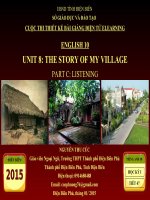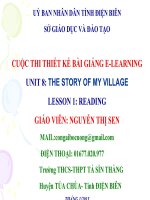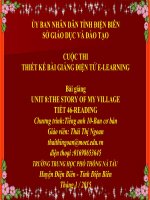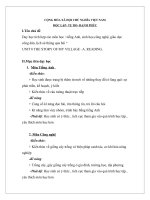Giáo án Tiếng Anh 10 Unit 8: The story of my village
Bạn đang xem bản rút gọn của tài liệu. Xem và tải ngay bản đầy đủ của tài liệu tại đây (200.02 KB, 50 trang )
Giáo án Tiếng Anh 10
UNIT 8: THE STORY OF MY VILLAGE
Theme: The story of my village
Unit 8: READING
Time: 45 minutes
I. OBJECTIVES:
1. Educational aim: Students should understand all the changes in the country life
nowadays
2. Knowledge:
- General knowledge: By the end of this lesson, students will be able to:
- better their reading skill through vocabulary Matching and
Table completion exercise
- enlarge vocabulary about country life
- Language
- New words: Words related to country life
3. Skill : Reading for gist and for specific information about country life
II. METHOD: Intergrated mainly communicative
III. TEACHING AIDS: Textbook, pictures about country life
IV. PROCEDURE:
1.Organization
2.Check old lesson
3.New lesson
Teacher’s activities
Students’ activities
Warm-up :(2 minutes)
- Greeting
- Answer freely
- Rasing some questions:
+ How are you today?
+ Do you like living in the city or - city/ country
living in the country?
+ Why do you like that?
- Say: “Well, today we’ll come to Unit
8: Reading to visit the life of the
village and discover some interesting
things in the country”
Pre-reading: (10 minutes)
- Ask students some questions:
1. What can you see in the picture?
2. Who are they?
- because of fresh air etc.
- Listen to the teacher
Notes
3. What are they using?
1. This is a picture of
village.
2. The farmers are.
- Open your book!
3. They are planting/
laughing etc.
* Vocabulary:
- Ask students to read through the
passage and find some new words
+ straw (n): dry cut stalks of various
- Read individually
cereals
+ mud (n): wet, soft soil
+ brick houses: houses made of bricks
- Listen to the teacher
and write down
+ thanks to (prep): owing to, because
of
+ farming methods (n): phương pháp
canh tác
- Ask students read all the new words
in chorus
- Call some students to read again
- Read in chorus
- Check pronunciation
* Ask students to work in pairs and
- Read individually
discuss the questions in the book
- Call on some students to give their
answers
- Listen and correct
- Work in pairs and give
answers
1.
The
farmers
are
harvesting crop.
2. They are working very
hard.
3. It’s a good/ bumper
crop.
4.
Good
farming
methods, good varieties,
modern technology used,
people work hard
While-reading: (22 minutes)
You’re going to read a passage about
- Listen to the teacher
life changes in the country. You
should read it and do the tasks.
* Task 1: Vocabulary Matching
- Ask students to read all the words in
A, then read the passage to underline - Read the passage and
those words which all appear in the underline new words
passage
- Encourage students to guess the
meanings of the words in the context
- Have students compare their answers
with a friend
-
Try
to
guess
the
meanings of the words
- Work in pairs
- Call on some students to explain their
answers in front of the class
- Make necessary corrections
- Listen to their friends’
answers
- Give correct answers:
1.b - 2.d - 3.a - 4.e - 5.c
- Ask students to translate those word
phrases into Vietnamese
- Listen to the teacher
and correct
- Do translating
- Check their answers by giving
Vietnamese equivalents if necessary
1. kiếm tằn tiện đủ sống
2. thiếu thốn nhiều thứ
- Listen to the teacher
and
take
necessary
3. cải thiện cuộc sống
4. vụ mùa bội thu
5. cây trồng để bán và thu lợi nhuận
* Task 2:
- Let students read the table carefully
before doing the task
- Read the task
notes
if
- Ask students to scan the passage to
get specific information and find out
the sentences which related to the
- Work individually
words in the first column of the table
- Go round the class and provide help
when necessary
- Let students compare their answers
with a friend
- Check the answers in front of the
class as a whole
- Work in pairs
- Give correct answers
* Task 3: Answering questions
- Ask students to read the passage
again and then do the task 3
- Tell students to underline the
information that support the answers
- Read independently
- Have students compare their answers
with a friend
- Call on some students to read aloud
their answers in front of the class and
give explaination
- Give feedback and correct answers
- Work in pairs
1. It was poor and simple.
2. Because they hope that… (the last
sentence-1st paragraph)
3. They introduced… (2nd sentence-2nd
paragraph)
- Listen to the teacher
and correct the answers
4. He said their lives… (3rd paragraph)
5. He told … (4th paragraph)
Post- reading: (10 minutes)
- Ask students to work in groups and
discuss the question: How can people
with an education help make the life of
their community better?
- Tell students to look back to the
passage to get the ideas for the
questions
- Work in groups and
answer the question
- Go around and help students if
necessary
- Listen and check
- Give suggested answers:
+ Introduce new farming methods
+ Grow cash crops for export
+ Help local people apply modern - One student present the
technology in farming
+ Help community especially young
answers in front of the
class
people access to ways of entertainment
+ Raise people’s awareness about
food safety and environmental hygiene
- Listen to the teacher
and write down
Homework: (1 minutes)
- Ask students to write about the - Copy down on the
changes in their village nowadays (100 notebooks
words) at home
V.THE SELF EVALUATION AFTR CLASS
Theme: The story of my village
Unit 8: SPEAKING
Time: 45 minutes
I. OBJECTIVES:
1. Educational aim: Students should understand how to talk about their plans and
results
2. Knowledge:
- General knowledge: By the end of this lesson, students will be able to talk about
plans to improve life of a village and their possible results
- Language
- New words: Words related to verbs of improving life in a village
3. Skill : Speaking about their own plans to improve life of a village fluently
II. METHOD: Intergrated mainly communicative
II. TEACHING AIDS: Textbook, black board
III. PROCEDURE:
1.Organization
2.Check old lesson
3.New lesson
Teacher’s activities
Students’ activities
Notes
Pre-speaking: (10 minutes)
Brainstorming
- Tell students to close the book
- Ask students to work in groups
- Work in groups
- Ask students to make the list of ideas
that can be carried out to improve the
village life
- Ask the groups to raise their ideas
- Take notes on the board
- Say: “Ok, your ideas are very good.
You’re very honor to improve your - Listen to the teacher
village. And in order to help you more,
we’ll go to part Speaking, Task 1 and
find how the villagers of Ha Xuyen
improve their lives in the village”
While-speaking: (25 minutes)
* Task 1:
- Ask students to open the book and
look at the situation in Task 1 and read
the content first
- Ask students to do Matching
- Work individually
- Expalin some possible new words:
+ resurface (v) = renew
+ canal (n): man-made waterway for - Write down
irrigation
+ mudly (adj): full of mud
- Call on some students to read aloud
their answers in front of the class and
give their explanation for their answers
- Check the answers again in front of
the class as a whole
- Listen to their friends’
- Give correct answers:
answers
1.b - 2.g - 3.d - 4.e - 5.f - 6.c
* Task 2:
- Correct the answers
- Let students work in groups of three:
read and practise the conversation in
task 2
- Go around and help students if
needed
- Call on some groups to practise the
conversation in front of the class
- Check their pronunciation
- Work in groups
- Give the structure of Conditional - Practise speaking the
sentence type 1
If clause
conversation
,
If + S + do
main clause
, S + will/ can… +
do
- Ask students to give comments on
the structure
- Conditional Sentence
Type
1
is
express
something can happen in
- Ask students to make more sentences
with the above structure
the present
- S1: If he studies hard,
he’ll not fail the exam.
Post- speaking: (10 minutes)
- S2: …..
* Task 3:
- Keep students to work in groups and
- Work in groups
continue the conversation, using the
ideas in the table in Task 1 or their
own
ideas
by
using
Conditional
Sentence Type 1
- Go around the class and provide help
when necessary
- Call on some groups to act out the - Ask the teacher if
conversation in front of the class
-
Give
comments
and necessary necessary
corrections
- Some groups present
their
Homework: (2 minutes)
conversations
in
front of the class
- Write a conversation about your
village
- Listen to the teacher
and write down
V.THE SELF EVALUATION AFTR CLASS
Theme: The story of my village
Unit 8: LISTENING
Time: 45 minutes
I. OBJECTIVES:
1. Educational aim: Students can listen for information about the changes of a
small town in England
2. Knowledge:
- General knowledge: By the end of this lesson, students will be able to:
- compare the past and the present of a town
- improve listening skill through T/F and Gap-filling
exercises
- Language
- New words: Words related to verbs of improving life in a village
3. Skill : Listening to a specific information
II. METHOD: Intergrated mainly communicative
III. TEACHING AIDS: Textbook, black board, cassette player…
IV. PROCEDURE:
1.Organization
2.Check old lesson
3.New lesson
Teacher’s activities
Students’ activities
Pre-listening: (14 minutes)
-Ask students to look at two pictures - Look at the pictures
of the same town in the book and find and do the task under the
as many the differences as possible teacher’s instruction
between them
- Ask students to work in pairs
- Call on some students to share their
findings in front of the class
- Work in pairs
- Some students present
their findings aloud
Ex: car, small road, buffalos etc.
- Review the structure of “used to” : to
express a past habit
- Retell the structure and
how to use it
Form:
+ S + used to + V + O
- S + didn’t use to + V + O
? Did + S + use to + V + O?
- Give more structures related to “used
to”
+ To be/to get used to + V-ing
(to express a present habit)
- Listen to the teacher
and write down on the
notebooks
Notes
- Give examples and to analyse the - Listen to the teacher
difference between two structures
Ex:
1. My father used to smoke.
2. My father is/gets used to smoking.
(1): My father smoked in the past, and
now he doesn’t smoke
(2): My father is smoking now.
- Ask students to make more sentences
with the above structures
- Correct the mistakes
A: I used to cry at
midnight when I was a
child.
B: I used to play with a
doll when I was 5.
C: I get used to going to
bed late.
………………………
While-listening: (20 minutes)
You will hear someone talk about the
changes in his hometown. Listen to the
talk and do the tasks that follow.
* Task 1: True or False
- Ask students to guess if the - Do guessing
statements are T or F before listening
- Let students give answers in chorus
- Answer in chorus: 1. F/
- Say: “Ok, now, listen to the tape and 2. T ….
check your answers according to the
talk”
- Ask students to do the task
individually first
- Work independently
- Play the tape several times if
necessary
- Have students compare their answers
with a friend and correct the false ones
- Work in pairs
- Call on some students to read their
answers aloud in front of the class
- Feedback and give correct answers
- Listen to their friends
and find out mistakes
1. F (It’s on the south coast of
England)
2. F (It’s used to be a small quiet
town)
3. T
4. F (A lot of trees have been cut down
- Correct the answers
for wider streets)
5. F (Some people don’t like the
changes, they miss the quiet and
peaceful life of the old town)
* Task 2: Gap-filling
- Tell students to read a part of the talk
carefully and have a guess of the
missing words before listening
-
Read
the
talk
- Ask students to listen to the tape individuaaly
again and fill the gaps with the words
they hear
- Listen to the tape again
- Play the tape more than once if and do the task
necessary
- Remind students to write the exact
and grammatically correct words
- Call on some students to explain their
answers in front of the class
- Correct the answers by playing the - Correct the answers:
tape sentence by sentence
1.house-2.hotel3.widened-4.cut-5.car
Post- listening: (10 minutes)
6.shop-7.department8.expensive
- Ask students to work in groups to
discuss the changes in your own
hometown or home village
- Notice students to use the present
perfect and “used to” to show the
changes: there is/are used to; there
- Work in groups and do
discussing
used to be…
- Go around the class to provide help
- Call some students to give their short
talks in front of the class
-
Have
comments
on
students’
performance and correct the mistakes
Homework: (1 minutes)
- Write 10 sentences about what you
used to do in the past and what you are
used to doing in the present at home
- Write down
V.THE SELF EVALUATION AFTR CLASS
Theme: The story of my village
Unit 8: WRITING
Time: 45 minutes
I. OBJECTIVES:
1. Educational aim: Students can write and give direction to a certain place to
somebody
2. Knowledge:
- General knowledge: By the end of this lesson, students will be able to write a
letter giving directions to a certain place
- Language
- New words: Words related to direction verb-phrases
3. Skill : Writing a letter giving directions
II. METHOD: Intergrated mainly communicative
II. TEACHING AIDS: Textbook, photocopy of the A0-sized map
III. PROCEDURE:
1.Organization
2.Check old lesson
3.New lesson
Teacher’s activities
Students’ activities
Notes
Warm-up: (4 minutes)
- Ask students some questions:
1. Where do you live?
2. What’s your address?
3. Class! Do you know the place
where she/ he lives? Could you show
me how to get there?
- Say: “Ok, today we’ll learn how to
give directions to a certain place. Open
your book! P.87”
Pre-writing: (5 minutes)
- Call on 2 students to go the board
and follow teacher’s directions (using
direction sentences)
Come on! turn right, go ahead, go
past Linh, turn left. Well, sit down,
please!
- Ask students to realize/show how to
show the way to a place
- Say: “Is it interesting? Now, look at
your book and read the letter individually,
then underline direction phrases”
While-writing: (20 minutes)
* Task 2:
- Explain some new words by using
signals and wrote on the board:
+ come (get) out
+ turn right/ left
+ keep walking
+ go over
+ walk past
+ take the first/ second
- Give more words:
+ go ahead = keep straight
+ go along
+ go down/ up ect.
- Let students read aloud these words
in chorus
- Call some students to read new
words to check pronunciation
* Ask students stop reading
- Ask students to find Ann’s house on
the map in the book in pairs following
the intruction in the letter
- Check the answer in chorus
* Task 1:
- Tell students to read the letter again
quickly
- Hang the A0-sized map on the board
- Ask students to look at the map and
find Ann’s house
- Call one students to go to the board
and show the way to Ann’s house on
the large map in front of the class
- Confirm the direction again
Post- writing: (15 minutes)
Your house is A on the map. Write a
letter to Jim, telling him the way to
your house from Roston Railway
Station
- Ask students to write the letter
independently
- Remind students to use directionphrases
- Go around to provide help if
necessary
- Have students compare their writing
with a friend
- Pick up some writings and correct in
front of the class
Homework: (1 minutes)
- Write a letter to your friend to show
the way to Nguyen Trai High School
V.THE SELF EVALUATION AFTR CLASS
Theme: The story of my village
Unit 8: LANGUAGE FOCUS
Time: 45 minutes
I. OBJECTIVES:
1. Educational aim: Students can pronounce 2 sounds / au / - / ∂u / correctly and
understand how to use reported speech and conditional
sentence type 1
2. Knowledge:
- General knowledge: By the end of this lesson, students will be able to:
- pronounce the sounds / au / - / ∂u / clearly and correctly
- transform direct speeck into reported speech following
correct rules
- say the difference between when and if in conditional
sentence type 1 and do related exercises
- Language
- New word: Words related to reported speech and conditional sentence-1
3. Skill : Pronouncing 2 sounds / au / and / ∂u / correctly
II. METHOD: Intergrated mainly communicative
III. TEACHING AIDS: Textbook, an A0-sized map, hand-outs
IV. PROCEDURE:









